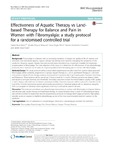Mostrar o rexistro simple do ítem
Effectiveness of aquatic therapy vs land-based therapy for balance and pain in women with fibromyalgia: a study protocol for a randomised controlled trial
| dc.contributor.author | Rivas Neira, Sabela | |
| dc.contributor.author | Marques, Amélia Pasqual | |
| dc.contributor.author | Pegito, Irene | |
| dc.contributor.author | Fernández-Cervantes, Ramón | |
| dc.contributor.author | Vivas-Costa, Jamile | |
| dc.date.accessioned | 2017-03-23T11:32:58Z | |
| dc.date.available | 2017-03-23T11:32:58Z | |
| dc.date.issued | 2017-01-19 | |
| dc.identifier.citation | Rivas Neira S, Marques AP, Pegito Pérez I, Fernández Cervantes R, Vivas Costa J. Effectiveness of aquatic therapy vs land-based therapy for balance and pain in women with fibromyalgia: a study protocol for a randomised controlled trial. BMC Musculoskelet Disord [Internet]. 2017 Jan 19;18. | es_ES |
| dc.identifier.issn | 1471-2474 | |
| dc.identifier.uri | http://hdl.handle.net/2183/18326 | |
| dc.description | Date of publication in ClinicalTrials.gov: 18/02/2016. ClinicalTrials.gov Identifier: NCT02695875. | es_ES |
| dc.description.abstract | [Abstract] Background. Fibromyalgia is a disease with an increasing incidence. It impairs the quality of life of patients and decreases their functional capacity. Aquatic therapy has already been used for managing the symptoms of this syndrome. However, aquatic therapy has only recently been introduced as a treatment modality for improving proprioception in fibromyalgia. The main objective of this study is to determine the effectiveness of two physiotherapy protocols, one in and one out of water, for improving balance and decreasing pain in women with fibromyalgia. Methods/Design. The study protocol will be a single-blind randomised controlled trial. Forty women diagnosed with fibromyalgia will be randomly assigned into 2 groups: Aquatic Therapy (n = 20) or Land-based Therapy (n = 20). Both interventions include 60-min therapy sessions, structured into 4 sections: Warm-up, Proprioceptive Exercises, Stretching and Relaxation. These sessions will be carried out 3 times a week for 3 months. Primary outcomes are balance (static and dynamic) and pain (intensity and threshold). Secondary outcomes include functional balance, quality of life, quality of sleep, fatigue, self-confidence in balance and physical ability. Outcome measures will be evaluated at baseline, at the end of the 3-month intervention period, and 6-weeks post-treatment. Statistical analysis will be carried out using the SPSS 21.0 program for Windows and a significance level of p ≤ 0.05 will be used for all tests. Discussion. This study protocol details two physiotherapy interventions in women with fibromyalgia to improve balance and decrease pain: aquatic therapy and land-based therapy. In current literature there is a lack of methodological rigour and a limited number of studies that describe physiotherapy protocols to manage fibromyalgia symptoms. High-quality scientific works are required to highlight physiotherapy as one of the most recommended treatment options for this syndrome. | es_ES |
| dc.language.iso | eng | es_ES |
| dc.publisher | BioMed Central | es_ES |
| dc.relation.uri | http://dx.doi.org/10.1186/s12891-016-1364-5 | es_ES |
| dc.rights | Atribución 3.0 España | es_ES |
| dc.rights.uri | http://creativecommons.org/licenses/by/3.0/es/ | * |
| dc.subject | Fibromyalgia | es_ES |
| dc.subject | Physiotherapy | es_ES |
| dc.subject | Pain | es_ES |
| dc.subject | Postural balance | es_ES |
| dc.subject | Aquatic therapy | es_ES |
| dc.subject | Exercise | es_ES |
| dc.title | Effectiveness of aquatic therapy vs land-based therapy for balance and pain in women with fibromyalgia: a study protocol for a randomised controlled trial | es_ES |
| dc.type | info:eu-repo/semantics/article | es_ES |
| dc.rights.access | info:eu-repo/semantics/openAccess | es_ES |
| UDC.journalTitle | BMC Musculoskletal Disorders | es_ES |
| UDC.volume | 18 | es_ES |
Ficheiros no ítem
Este ítem aparece na(s) seguinte(s) colección(s)
-
GI-IPRF - Artigos [139]






